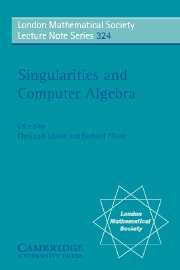Book contents
- Frontmatter
- Contents
- Preface
- Invited Lectures
- List of Participants
- Aspects of Gert-Martin Greuel's Mathematical Work
- Exterior Algebra Methods for the Construction of Rational Surfaces in the Projective Fourspace
- Superisolated Surface Singularities
- Linear Free Divisors and Quiver Representations
- Derived Categories of Modules and Coherent Sheaves
- Monodromy
- Algorithmic Resolution of Singularities
- Newton Polyhedra of Discriminants: A Computation
- Depth and Differential Forms
- The Geometry of the Versal Deformation
- 21 Years of SINGULAR Experiments in Mathematics
- The Patchworking Construction in Tropical Enumerative Geometry
- Adjunction Conditions for One-Forms on Surfaces in Projective Three-Space
- Sextic Surfaces with Ten Triple Points
- Sextic Surfaces with 10 Triple Points
- Topology, Geometry, and Equations of Normal Surface Singularities
Superisolated Surface Singularities
Published online by Cambridge University Press: 11 November 2009
- Frontmatter
- Contents
- Preface
- Invited Lectures
- List of Participants
- Aspects of Gert-Martin Greuel's Mathematical Work
- Exterior Algebra Methods for the Construction of Rational Surfaces in the Projective Fourspace
- Superisolated Surface Singularities
- Linear Free Divisors and Quiver Representations
- Derived Categories of Modules and Coherent Sheaves
- Monodromy
- Algorithmic Resolution of Singularities
- Newton Polyhedra of Discriminants: A Computation
- Depth and Differential Forms
- The Geometry of the Versal Deformation
- 21 Years of SINGULAR Experiments in Mathematics
- The Patchworking Construction in Tropical Enumerative Geometry
- Adjunction Conditions for One-Forms on Surfaces in Projective Three-Space
- Sextic Surfaces with Ten Triple Points
- Sextic Surfaces with 10 Triple Points
- Topology, Geometry, and Equations of Normal Surface Singularities
Summary
Abstract
In this survey, we review part of the theory of superisolated surface singularities (SIS) and its applications including some new and recent devlopments. The class of SIS singularities is, in some sense, the simplest class of germs of normal surface singularities. Namely, their tangent cones are reduced curves and the geometry and topology of the SIS singularities can be deduced from them. Thus this class contains, in a canonical way, all the complex projective plane curve theory, which gives a series of nice examples and counterexamples. They were introduced by I. Luengo to show the non-smoothness of the μ-constant stratum and have been used to answer negatively some other interesting open questions. We review them and the new results on normal surface singularities whose link are rational homology spheres. We also discuss some positive results which have been proved for SIS singularities.
Introduction
A superisolated surface, SIS for short, singularity (V, 0) ⊂ (ℂ3, 0) is a generic perturbation of the cone over a (singular) reduced projective plane curve C of degree d, C = {fd(x, y, z)= 0} ⊂ ℙ2, by monomials of higher degree. The geometry, resolution and topology of (V, 0) is determined by the singularities of C and the pair (ℙ2,C). This provides a canonical way to embed the classical and rich theory of complex projective plane curves into the theory of normal surface singularities of (ℂ3; 0).
- Type
- Chapter
- Information
- Singularities and Computer Algebra , pp. 13 - 40Publisher: Cambridge University PressPrint publication year: 2006
- 3
- Cited by



